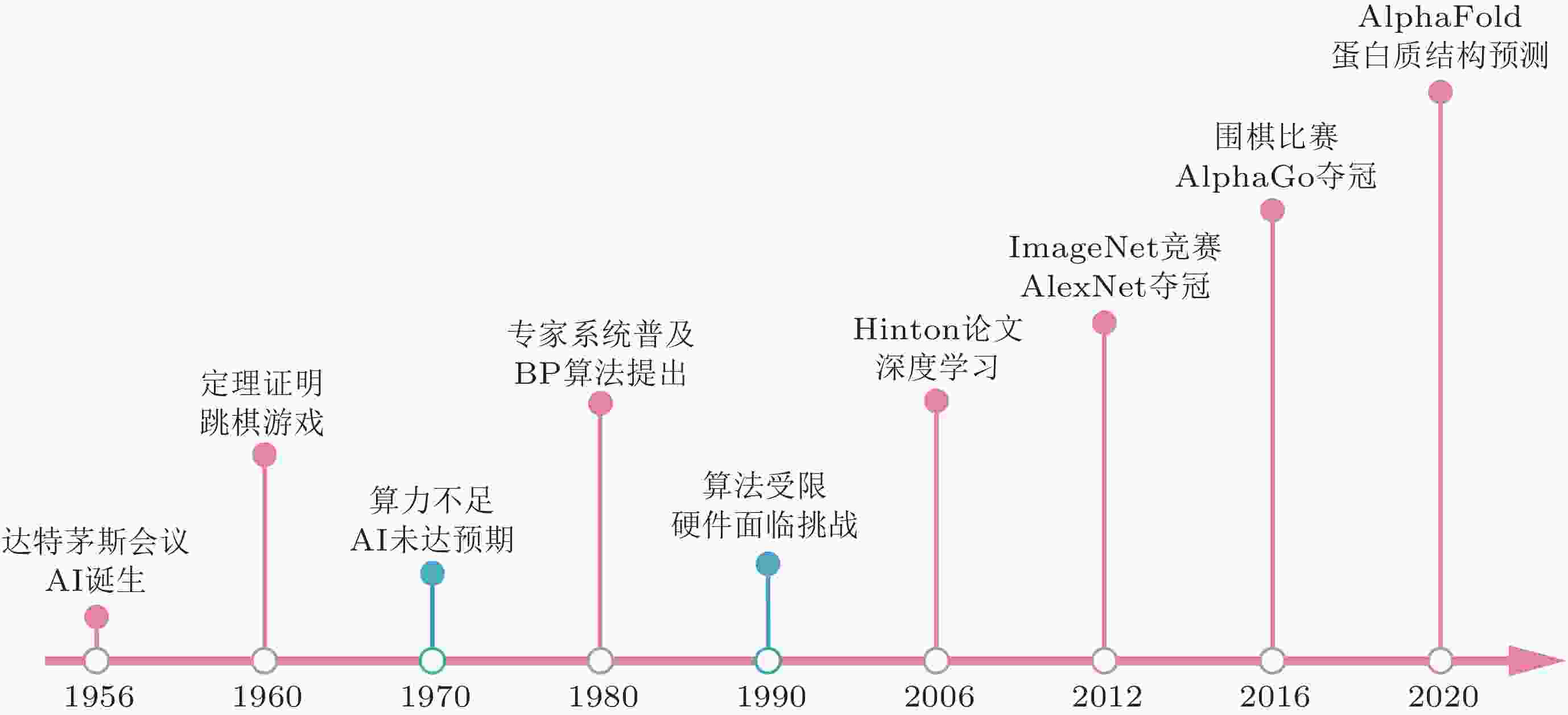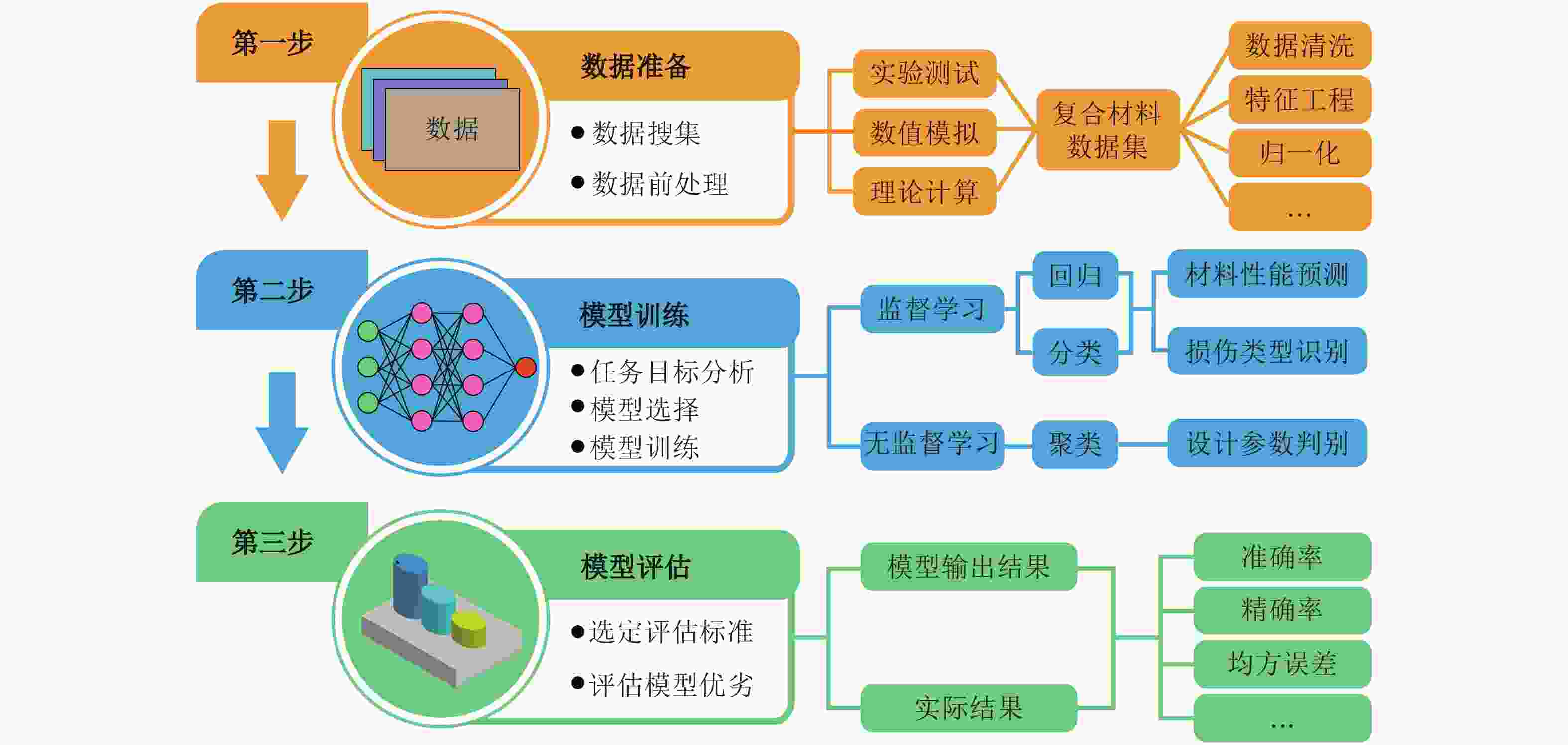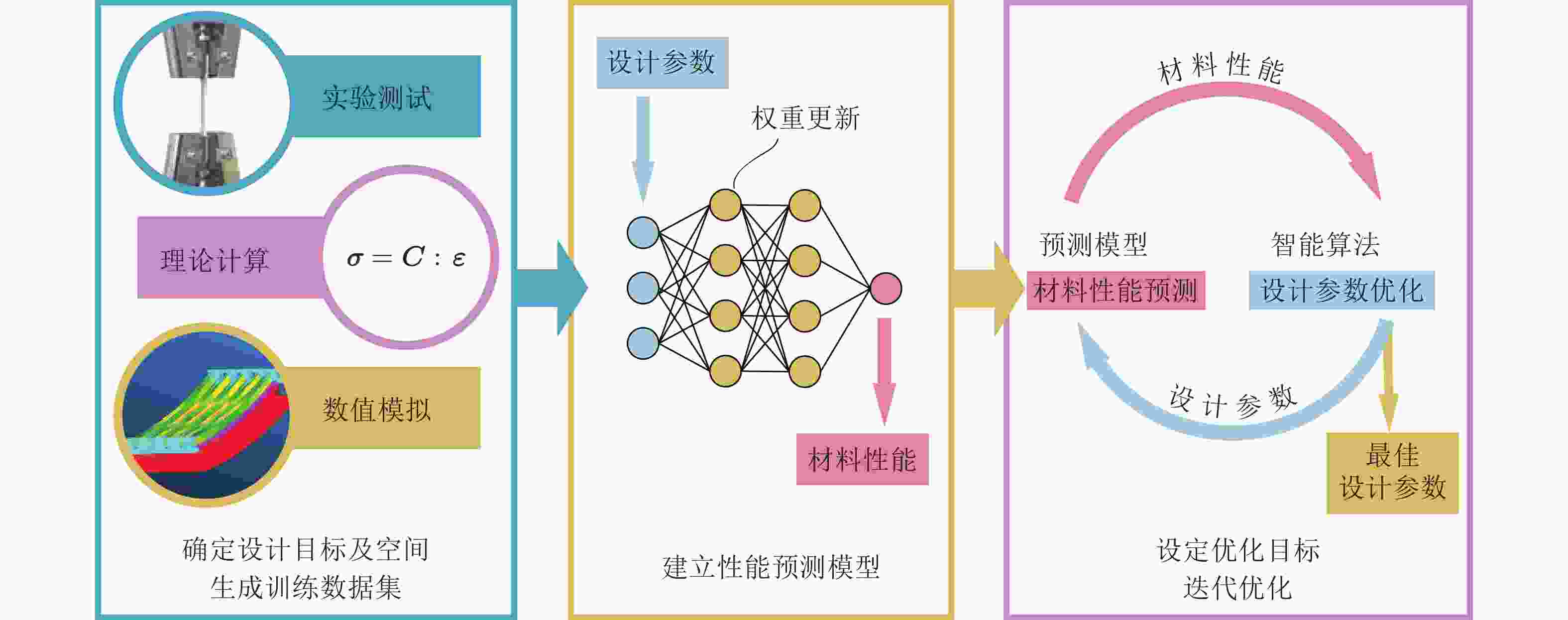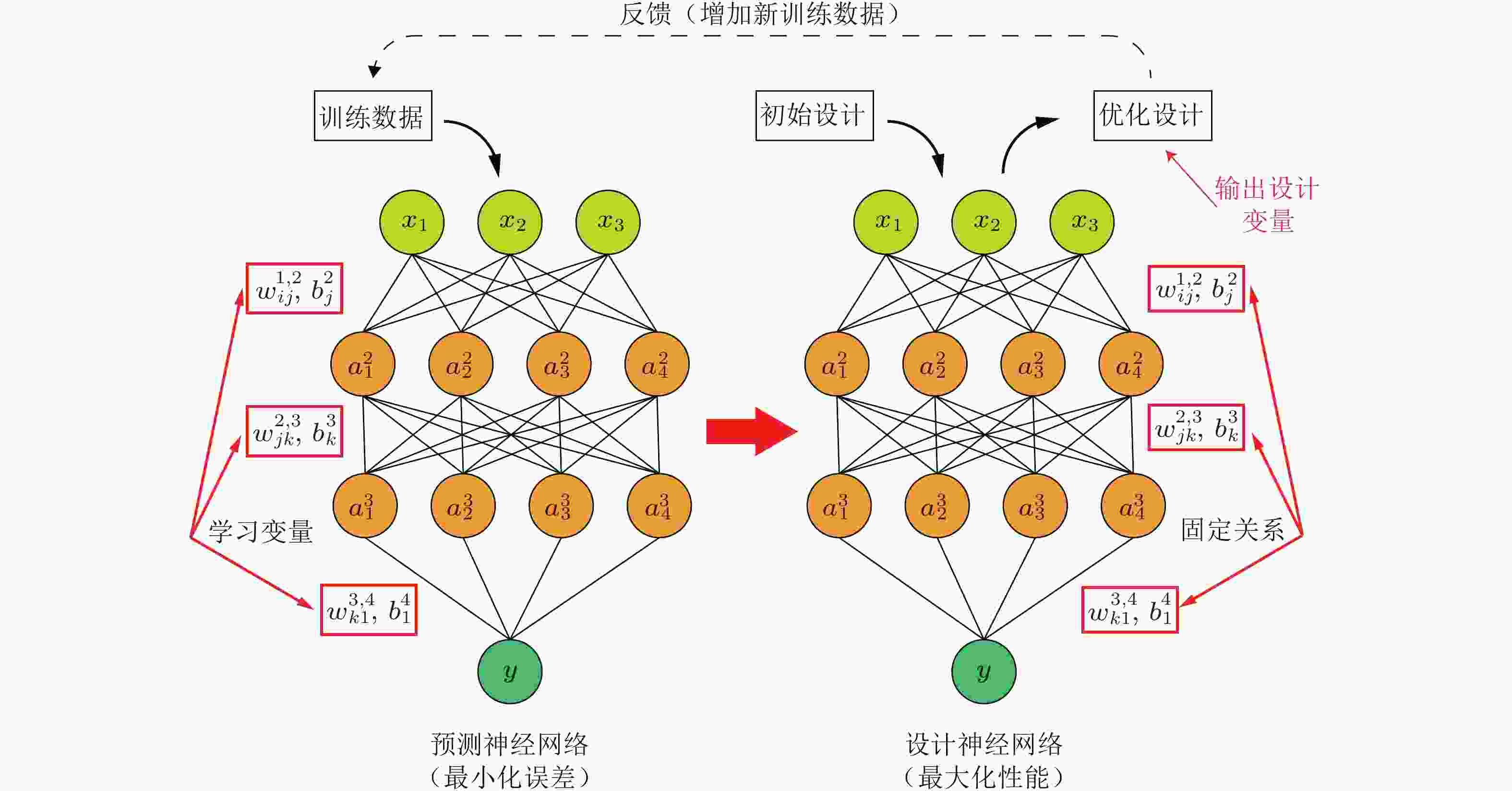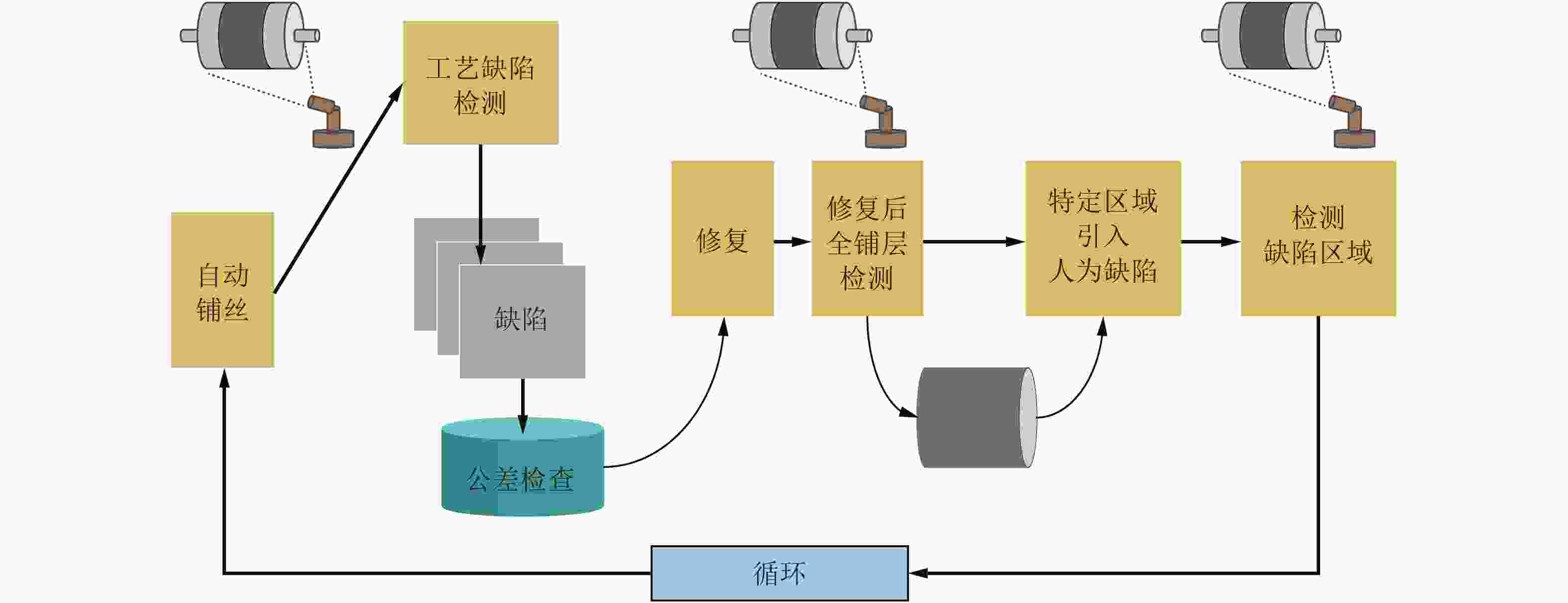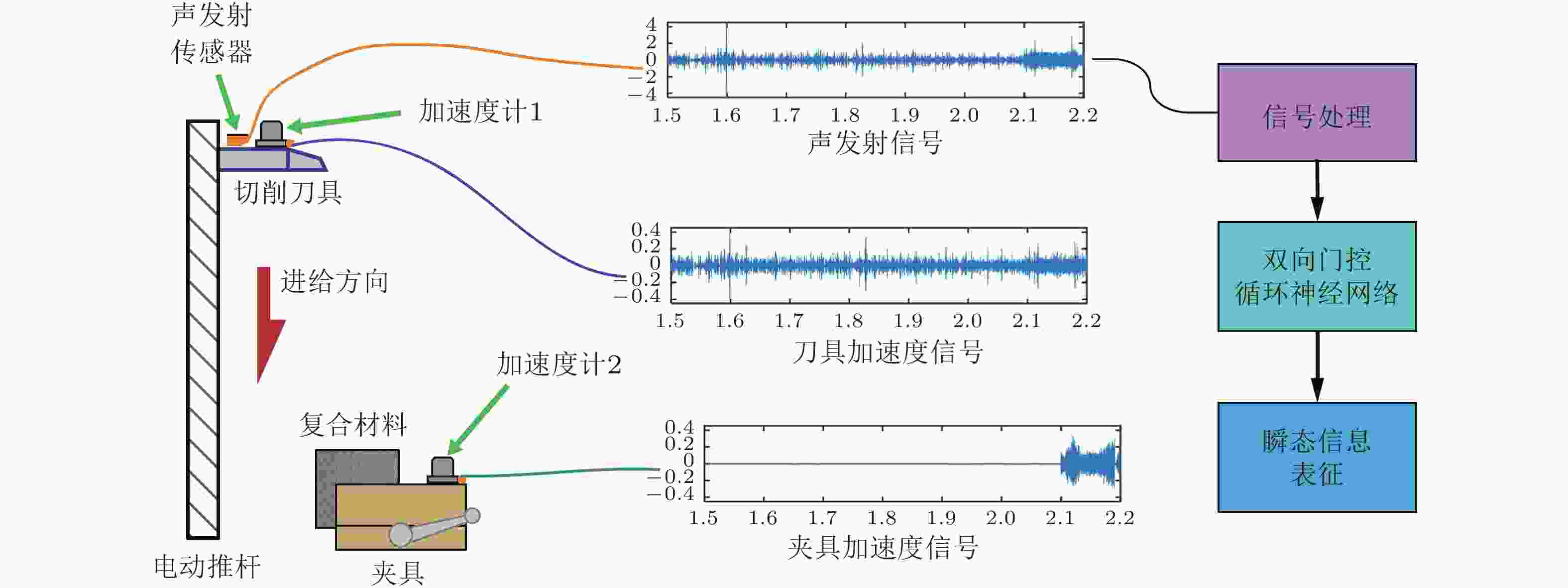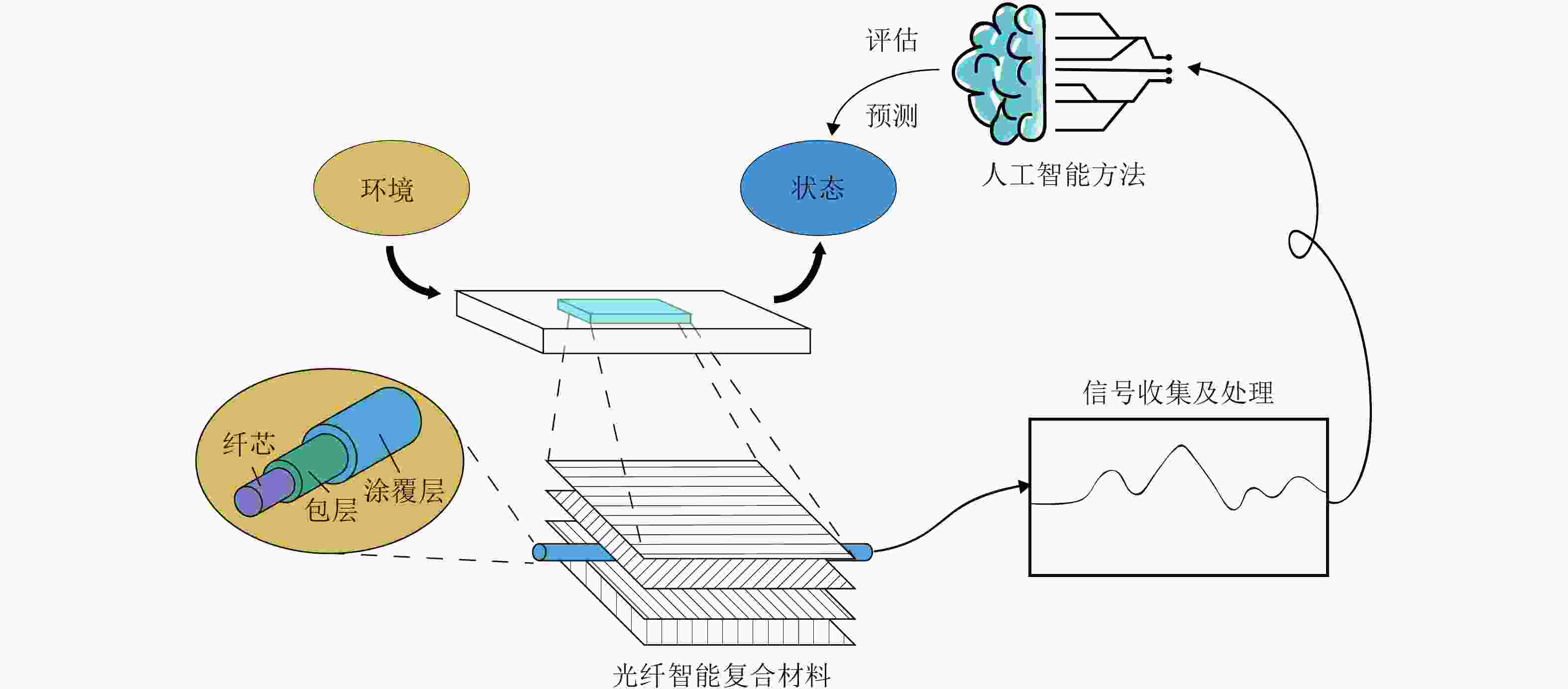-
摘要: 复合材料以其轻质高强高模、可设计性强等优点成为结构轻量化的重要用材. 然而, 随着复合材料组分、结构以及性能需求的日益复杂化, 以实验观测、理论建模和数值模拟为主体的传统研究范式, 在复合材料力学性能分析、设计和制造等方面遇到了新的科学问题与技术瓶颈. 其中, 实验观测不足、理论模型缺乏、数值分析受限、结果验证困难等问题在一定程度上制约了先进复合材料在面向未来工程领域中应用的发展. 人工智能方法以数据驱动的模型替代传统研究中的数学力学模型, 直接由高维高通量数据建立变量间的复杂关系, 捕捉传统力学研究方法难以发现的规律, 在复杂系统的分析、预测、优化方面拥有与生俱来的优势. 而通过人工智能赋能来寻求复合材料中传统研究方法所面临难题的新的解决方案, 目前已成为复合材料研究领域的发展趋势. 本文综述并评价了人工智能方法在复合材料性能预测、优化设计、制造检测及健康监测等方面的研究进展, 并对未来发展方向进行了探讨和展望.Abstract: Composite materials have become the major materials of light-weight structure due to their light weight, high strength, high modulus, and strong designability. However, as the component, structure and requirements of capability become increasingly complex, traditional research methods based on experiment, theoretical modeling and numerical simulation meet lots of new problems in the properties prediction, design optimization, manufacturing and processing of composite materials. Insufficient experimental observation, lacking theoretical model, constrained numerical simulation and difficult conclusion validation have seriously restricted the development of advanced composite materials in the future-oriented engineering. Instead of the mathematical models used by mechanics, data-driven models are used in the Artificial Intelligence. It directly establishes the complex relationship between variables from high-dimensional and high-throughput data, then captures the laws that are difficult to be discovered by traditional mechanical method, shows natural advantages in simulation, prediction, optimization in complex systems. It has become the development trend in the field of composite materials to find new solutions to the problems faced by traditional methods through Artificial Intelligence. In this paper, the status of properties prediction, design optimization, manufacturing and health monitoring is introduced. The future development direction of this field is discussed.
-
Key words:
- composite materials /
- artificial intelligence /
- mechanical properties /
- design /
- manufacturing
-
图 9 逆设计生成网络(Chen & Gu 2020)
图 10 基于人工智能的自动铺丝视觉检查系统(Sacco et al. 2020)
-
[1] 杜善义, 关志东. 2008. 我国大型客机先进复合材料技术应对策略思考. 复合材料学报, 1: 1-10 (Du S Y, Guan Z D. 2008. Strategic considerations for development of advanced composite technology for large commercial aircraft in China. Acta Materiae Compositae Sinica, 1: 1-10). doi: 10.3321/j.issn:1000-3851.2008.01.001 [2] 宁莉, 杨绍昌, 冷悦, 任学明, 苏霞, 闫超. 2020. 先进复合材料在飞机上的应用及其制造技术发展概述. 复合材料科学与工程, 5: 123-128 (Ning L, Yang S C, Leng Y, Ren X M, Su X, Yan C. 2020. Overview of the application of advanced composite materials on aircraft and the development of its manufacturing technology. Composites Science and Engineering, 5: 123-128). doi: 10.3969/j.issn.1003-0999.2020.09.020 [3] 亓欣波, 陈国锋, 李勇, 程宣, 李长鹏. 2019. 将基于神经网络的机器学习方法应用于增材制造——应用现状、当前挑战和未来前景. 工程, 5: 275-294 (Qi X B, Chen G F, Li Y, Cheng X, Li C P. 2019. Applying neural-network-based machine learning to additive manufacturing: current applications, challenges, and future perspectives. Engineering, 5: 275-294). [4] 吴陈铭, 戴澄恺, 王昌凌, 刘永进. 2019. 多自由度3D打印技术研究进展综述. 计算机学报, 42: 1918-1938 (Wu C M, Dai C K, Wang C L, Liu Y J. 2019. Recent Progress on Multi-DOF 3D Printing: A Survey. Chinese Journal of Computers, 42: 1918-1938). doi: 10.11897/SP.J.1016.2019.01918 [5] 杨乃宾. 2008. 新一代大型客机复合材料结构. 航空学报, 3: 596-604 (Yang N B. 2008. Composite structures for new generation large commercial jet. Acta Aeronautica ET Astronautica Sinica, 3: 596-604). doi: 10.3321/j.issn:1000-6893.2008.03.010 [6] Addona D D, Teti R, Caprino G. 2012. Residual strength prediction of artificially damaged composite laminates based on neural networks. Journal of Intelligent & Fuzzy Systems, 23: 217-223. [7] Al-Assadi M, El Kadi H, Deiab I M. 2009. Predicting the fatigue life of different composite materials using artificial neural networks. Applied Composite Materials, 17: 1-14. [8] Al-Assadi M, El Kadi H A, Deiab I M. 2010. Using artificial neural networks to predict the fatigue life of different composite materials including the stress ratio effect. Applied Composite Materials, 18: 297-309. [9] Aleksendrić D, Carlone P, Ćirović V. 2016. Optimization of the temperature-time curve for the curing process of thermoset matrix composites. Applied Composite Materials, 23: 1047-1063. doi: 10.1007/s10443-016-9499-y [10] Alvarez-Montoya J, Carvajal-Castrillón A, Sierra-Pérez J. 2020. In-flight and wireless damage detection in a UAV composite wing using fiber optic sensors and strain field pattern recognition. Mechanical Systems and Signal Processing, 136: 106526. doi: 10.1016/j.ymssp.2019.106526 [11] Antil S K, Antil P, Singh S, Kumar A, Pruncu C I. 2020. Artificial neural network and response surface methodology based analysis on solid particle erosion behavior of polymer matrix composites. Materials (Basel) , 13: 1-13. [12] António C C. 2014. A memetic algorithm based on multiple learning procedures for global optimal design of composite structures. Memetic Computing, 6: 113-131. doi: 10.1007/s12293-014-0132-z [13] António C C, Davim J P, Lapa V. 2007. Artificial neural network based on genetic learning for machining of polyetheretherketone composite materials. The International Journal of Advanced Manufacturing Technology, 39: 1101-1110. [14] António C C, Hoffbauer L N. 2010. Uncertainty propagation in inverse reliability-based design of composite structures. International Journal of Mechanics and Materials in Design, 6: 89-102. doi: 10.1007/s10999-010-9123-5 [15] António C C, Hoffbauer L N. 2013. Uncertainty assessment approach for composite structures based on global sensitivity indices. Composite Structures, 99: 202-212. doi: 10.1016/j.compstruct.2012.12.001 [16] Apalak M K, Karaboga D, Akay B. 2013. The artificial bee colony algorithm in layer optimization for the maximum fundamental frequency of symmetrical laminated composite plates. Engineering Optimization, 46: 420-437. [17] Artero-Guerrero J A, Pernas-Sánchez J, Martín-Montal J, Varas D, López-Puente J. 2018. The influence of laminate stacking sequence on ballistic limit using a combined Experimental/FEM/Artificial Neural Networks (ANN) methodology. Composite Structures, 183: 299-308. doi: 10.1016/j.compstruct.2017.03.068 [18] Aymerich F, Serra M. 1997. Prediction of fatigue strength of composite laminates by means of neural networks. Key Engineering Materials, 144: 231-242. doi: 10.4028/www.scientific.net/KEM.144.231 [19] Babu U H, Sai N V, Sahu R K. 2020. Artificial intelligence system approach for optimization of drilling parameters of glass-carbon fiber/polymer composites. Silicon. https://doi.org/10.1007/s12633-020-00637-5 [20] Bai G H, Meng S H, Zhang B M, Liu Y. 2008. Prediction on carbon/carbon composites ablative performance by artificial neutral net. Journal of Materials Science & Technology, 24: 945-952. [21] Ball N R, Sargent P M, Ige D O. 1993. Genetic algorithm representations for laminate layups. Artificial Intelligence in Engineering, 8: 99-108. doi: 10.1016/0954-1810(93)90020-G [22] Barbosa A, Upadhyaya P, Iype E. 2020. Neural network for mechanical property estimation of multilayered laminate composite. Materials Today: Proceedings, 28: 982-985. doi: 10.1016/j.matpr.2019.12.336 [23] Barry T J, Kesharaju M, Nagarajah C R, Palanisamy S. 2015. Defect characterisation in laminar composite structures using ultrasonic techniques and artificial neural networks. Journal of Composite Materials, 50: 861-871. [24] Bezerra E M, Ancelotti A C, Pardini L C, Rocco J A F F, Iha K, Ribeiro C H C. 2007. Artificial neural networks applied to epoxy composites reinforced with carbon and E-glass fibers: Analysis of the shear mechanical properties. Materials Science and Engineering: A, 464: 177-185. doi: 10.1016/j.msea.2007.01.131 [25] Bhoopal R S, Luyt A S, Sharma P K, Singh R. 2015. Prediction of the mechanical properties of copper powder-filled low-density polyethylene composites. a comparison between the ann and theoretical models. Composites: Mechanics, Computations, Applications: An International Journal, 6: 53-73. doi: 10.1615/CompMechComputApplIntJ.v6.i1.30 [26] Bisagni C, Lanzi L. 2002. Post-buckling optimisation of composite stiffened panels using neural networks. Composite Structures, 58: 237-247. doi: 10.1016/S0263-8223(02)00053-3 [27] Bobbili R, Madhu V. 2020. A machine learning approach in drilling of E-glass woven composites. Mechanics Based Design of Structures and Machines, 1-9. [28] Cacciola M, Lay-Ekuakille A, Megali G. 2013. Incremental Bayesian learning for in-service analysis of aeronautic composites. IET Science, Measurement & Technology, 7: 334-342. [29] Califano A, Chandarana N, Grassia L, D’Amore A, Soutis C. 2020. Damage detection in composites by artificial neural networks trained by using in situ distributed strains. Applied Composite Materials, 27: 657-671. doi: 10.1007/s10443-020-09829-z [30] Chakraborty D. 2005. Artificial neural network based delamination prediction in laminated composites. Materials & Design, 26: 1-7. [31] Chandrashekhara K, Okafor A C, Jiang Y P. 1998. Estimation of contact force on composite plates using impact-induced strain and neural networks. Composites Part B-Engineering, 29: 363-370. [32] Chen C T, Gu G X. 2020. Generative deep neural networks for inverse materials design using backpropagation and active learning. Adv Sci (Weinh) , 7: 1902607. doi: 10.1002/advs.201902607 [33] Chen R T Q, Rubanova Y, Bettencourt J, Duvenaud D. 2018. Neural ordinary differential equations. advances in neural information processing systems 31, La Jolla [34] Choi J H, Lee D G. 1995. Expert cure system for the carbon-fiber epoxy composite-materials. Journal of Composite Materials, 29: 1181-1200. doi: 10.1177/002199839502900903 [35] Cupertino L F, Vilela Neto O P, Pacheco M A C, Vellasco M B R, d'Almeida J R M. 2011. Modeling the Young modulus of nanocomposites: a neural network approach// 2011 International Joint Conference on Neural Networks, San Jose, CA [36] Daghigh V, Lacy T E, Daghigh H, Gu G, Baghaei K T, Horstemeyer M F, Pittman C U. 2020. Machine learning predictions on fracture toughness of multiscale bio-nano-composites. Journal of Reinforced Plastics and Composites, 39: 587-598. doi: 10.1177/0731684420915984 [37] De Fenza A, Sorrentino A, Vitiello P. 2015. Application of Artificial Neural Networks and Probability Ellipse methods for damage detection using Lamb waves. Composite Structures, 133: 390-403. doi: 10.1016/j.compstruct.2015.07.089 [38] Eder M A, Chen X. 2020. Fastigue: A computationally efficient approach for simulating discrete fatigue crack growth in large-scale structures. Engineering Fracture Mechanics, 233: 107075. doi: 10.1016/j.engfracmech.2020.107075 [39] Ehsani A, Dalir H. 2019. Multi-objective optimization of composite angle grid plates for maximum buckling load and minimum weight using genetic algorithms and neural networks. Composite Structures, 229: 111450. doi: 10.1016/j.compstruct.2019.111450 [40] El Kadi H. 2008. Predicting the crushing behavior of axially loaded elliptical composite tubes using artificial neural networks. Applied Composite Materials, 15: 273-285. doi: 10.1007/s10443-008-9074-2 [41] Erdal O, Sonmez F O. 2005. Optimum design of composite laminates for maximum buckling load capacity using simulated annealing. Composite Structures, 71: 45-52. doi: 10.1016/j.compstruct.2004.09.008 [42] Fernández-Fdz D, López-Puente J, Zaera R. 2008. Prediction of the behaviour of CFRPs against high-velocity impact of solids employing an artificial neural network methodology. Composites Part A: Applied Science and Manufacturing, 39: 989-996. doi: 10.1016/j.compositesa.2008.03.002 [43] Freirejr R, Neto A, Deaquino E. 2007. Use of modular networks in the building of constant life diagrams. International Journal of Fatigue, 29: 389-396. doi: 10.1016/j.ijfatigue.2006.06.005 [44] Fu T, Zhang Z, Liu Y, Leng J. 2015. Development of an artificial neural network for source localization using a fiber optic acoustic emission sensor array. Structural Health Monitoring: An International Journal, 14: 168-177. doi: 10.1177/1475921714568406 [45] Fu X, Ricci S, Bisagni C. 2015. Minimum-weight design for three dimensional woven composite stiffened panels using neural networks and genetic algorithms. Composite Structures, 134: 708-715. doi: 10.1016/j.compstruct.2015.08.077 [46] Gautam G D, Mishra D R. 2019. Firefly algorithm based optimization of kerf quality characteristics in pulsed Nd:YAG laser cutting of basalt fiber reinforced composite. Composites Part B: Engineering, 176: 107340. doi: 10.1016/j.compositesb.2019.107340 [47] Geng X, Lu S, Jiang M, Sui Q, Lv S, Xiao H, Jia Y, Jia L. 2018. Research on FBG-based cfrp structural damage identification using bp neural network. Photonic Sensors, 8: 168-175. doi: 10.1007/s13320-018-0466-0 [48] Gerrard D D, Fullwood D T, Halverson D M. 2014. Correlating structure topological metrics with bulk composite properties via neural network analysis. Computational Materials Science, 91: 20-27. doi: 10.1016/j.commatsci.2014.04.014 [49] Ghaboussi J, Pecknold D A, Zhang M F, Haj-Ali R M. 1998. Autoprogressive training of neural network constitutive models. International Journal for Numerical Methods in Engineering, 42: 105-126. doi: 10.1002/(SICI)1097-0207(19980515)42:1<105::AID-NME356>3.0.CO;2-V [50] Ghanem R, Soize C, Mehrez L, Aitharaju V. 2020. Probabilistic learning and updating of a digital twin for composite material systems. International Journal for Numerical Methods in Engineering, doi:10.1002/nme.6430" target="_blank">10.1002/nme.6430">doi:10.1002/nme.6430 [51] Graham D, Maas P, Donaldson G B, Carr C. 2004. Impact damage detection in carbon fibre composites using HTS SQUIDs and neural networks. NDT & E International, 37: 565-570. [52] Gu G X, Chen C-T, Buehler M J. 2018a. De novo composite design based on machine learning algorithm. Extreme Mechanics Letters, 18: 19-28. doi: 10.1016/j.eml.2017.10.001 [53] Gu G X, Chen C-T, Richmond D J, Buehler M J. 2018b. Bioinspired hierarchical composite design using machine learning: simulation, additive manufacturing, and experiment. Materials Horizons, 5: 939-945. doi: 10.1039/C8MH00653A [54] Hanafi I, Khamlichi A, Cabrera F M, Nuñez López P J, Jabbouri A. 2012. Fuzzy rule based predictive model for cutting force in turning of reinforced PEEK composite. Measurement, 45: 1424-1435. doi: 10.1016/j.measurement.2012.03.022 [55] Herencia J E, Weaver P M, Friswell M I. 2007. Optimization of long anisotropic laminated fiber composite panels with T-shaped stiffeners. Aiaa Journal, 45: 2497-2509. doi: 10.2514/1.26321 [56] Hinton G E, Salakhutdinov R R. 2006. Reducing the dimensionality of data with neural networks. Science, 313: 504-507. doi: 10.1126/science.1127647 [57] Hornik K. 1991. Approximation capabilities of multilayer feedforward networks. Neural Networks, 4: 251-257. doi: 10.1016/0893-6080(91)90009-T [58] Jac Fredo A R, Abilash R S, Femi R, Mythili A, Kumar C S. 2019. Classification of damages in composite images using Zernike moments and support vector machines. Composites Part B: Engineering, 168: 77-86. doi: 10.1016/j.compositesb.2018.12.064 [59] Jayatheertha C, Webber J P H, Morton S K. 1996. Application of artificial neural networks for the optimum design of a laminated plate. Computers & Structures, 59: 831-845. [60] Jeon W S, Song J H. 2002. An expert system for estimation of fatigue properties of metallic materials. International Journal of Fatigue, 24: 685-698. doi: 10.1016/S0142-1123(01)00184-0 [61] Jiang Z, Gyurova L A, Schlarb A K, Friedrich K, Zhang Z. 2008. Study on friction and wear behavior of polyphenylene sulfide composites reinforced by short carbon fibers and sub-micro TiO2 particles. Composites Science and Technology, 68: 734-742. doi: 10.1016/j.compscitech.2007.09.022 [62] Jin Z, Zhang Z, Gu G X. 2019. Automated real-time detection and prediction of interlayer imperfections in additive manufacturing processes using artificial intelligence. Advanced Intelligent Systems, 2: 1900130. [63] Just-Agosto F, Serrano D, Shafiq B, Cecchini A. 2008. Neural network based nondestructive evaluation of sandwich composites. Composites Part B: Engineering, 39: 217-225. doi: 10.1016/j.compositesb.2007.02.023 [64] Kalantari M, Dong C, Davies I J. 2017. Effect of matrix voids, fibre misalignment and thickness variation on multi-objective robust optimization of carbon/glass fibre-reinforced hybrid composites under flexural loading. Composites Part B: Engineering, 123: 136-147. doi: 10.1016/j.compositesb.2017.05.022 [65] Kalita K, Mukhopadhyay T, Dey P, Haldar S. 2019. Genetic programming-assisted multi-scale optimization for multi-objective dynamic performance of laminated composites: The advantage of more elementary-level analyses. Neural Computing and Applications, 32: 7969-7993. [66] Kamarian S, Shakeri M, Yas M H. 2018. Natural frequency analysis and optimal design of CNT/fiber/polymer hybrid composites plates using mori-tanaka approach, GDQ technique, and firefly algorithm. Polymer Composites, 39: 1433-1446. doi: 10.1002/pc.24083 [67] Kazi M K, Eljack F, Mahdi E. 2020. Optimal filler content for cotton fiber/PP composite based on mechanical properties using artificial neural network. Composite Structures, 251: 112654. doi: 10.1016/j.compstruct.2020.112654 [68] Khan A, Kim H S. 2018. Assessment of delaminated smart composite laminates via system identification and supervised learning. Composite Structures, 206: 354-362. doi: 10.1016/j.compstruct.2018.08.014 [69] Khan A, Kim H S. 2020. Classification and prediction of multidamages in smart composite laminates using discriminant analysis. Mechanics of Advanced Materials and Structures, 1-11. [70] Khan A, Ko D-K, Lim S C, Kim H S. 2019. Structural vibration-based classification and prediction of delamination in smart composite laminates using deep learning neural network. Composites Part B: Engineering, 161: 586-594. doi: 10.1016/j.compositesb.2018.12.118 [71] Khan S M, Malik S A, Gull N, Saleemi S, Islam A, Butt M T Z. 2019. Fabrication and modelling of the macro-mechanical properties of cross-ply laminated fibre-reinforced polymer composites using artificial neural network. Advanced Composite Materials, 28: 409-423. doi: 10.1080/09243046.2019.1573448 [72] Khatir S, Tiachacht S, Thanh C L, Bui T Q, Abdel Wahab M. 2019. Damage assessment in composite laminates using ANN-PSO-IGA and Cornwell indicator. Composite Structures, 230: 111509. doi: 10.1016/j.compstruct.2019.111509 [73] Kim J S. 2007. Development of a user-friendly expert system for composite laminate design. Composite Structures, 79: 76-83. doi: 10.1016/j.compstruct.2005.11.030 [74] Kim J S, Kim N P, Han S H. 2005. Optimal stiffness design of composite laminates for a train carbody by an expert system and enumeration method. Composite Structures, 68: 147-156. doi: 10.1016/j.compstruct.2004.03.009 [75] Konstantopoulos G, Koumoulos E P, Charitidis C A. 2020. Classification of mechanism of reinforcement in the fiber-matrix interface: Application of machine learning on nanoindentation data. Materials & Design, 192: 108705. [76] Laban O, Gowid S, Mahdi E, Musharavati F. 2020. Experimental investigation and artificial intelligence-based modeling of the residual impact damage effect on the crashworthiness of braided Carbon/Kevlar tubes. Composite Structures, 243: 112247. doi: 10.1016/j.compstruct.2020.112247 [77] Larrosa C, Lonkar K, Chang F-K. 2014. In situ damage classification for composite laminates using Gaussian discriminant analysis. Structural Health Monitoring: An International Journal, 13: 190-204. doi: 10.1177/1475921713517288 [78] Latha B, Senthilkumar V S. 2009. Analysis of thrust force in drilling glass fiber-reinforced plastic composites using fuzzy logic. Materials and Manufacturing Processes, 24: 509-516. doi: 10.1080/10426910802714688 [79] Latha B, Senthilkumar V S. 2010. Modeling and analysis of surface roughness parameters in drilling gfrp composites using fuzzy logic. Materials And Manufacturing Processes, 25: 817-827. doi: 10.1080/10426910903447261 [80] Lee J A, Almond D P, Harris B. 1999. The use of neural networks for the prediction of fatigue lives of composite materials. Composites Part a-Applied Science And Manufacturing, 30: 1159-1169. doi: 10.1016/S1359-835X(99)00027-5 [81] Lee K Y, Liebowitz H. 1995. An expert-system in fracture-mechanics. Engineering Fracture Mechanics, 50: 609-629. doi: 10.1016/0013-7944(94)E0048-L [82] Li J, Salim R D, Aldlemy M S, Abdullah J M, Yaseen Z M. 2018. Fiberglass-reinforced polyester composites fatigue prediction using novel data-intelligence model. Arabian Journal for Science and Engineering, 44: 3343-3356. [83] Li X, Liu Z, Cui S, Luo C, Li C, Zhuang Z. 2019. Predicting the effective mechanical property of heterogeneous materials by image based modeling and deep learning. Computer Methods in Applied Mechanics and Engineering, 347: 735-753. doi: 10.1016/j.cma.2019.01.005 [84] Liu P, Xu D, Li J, Chen Z, Wang S, Leng J, Zhu R, Jiao L, Liu W, Li Z. 2019a. Damage mode identification of composite wind turbine blade under accelerated fatigue loads using acoustic emission and machine learning. Structural Health Monitoring, 19: 1092-1103. [85] Liu X, Athanasiou C E, Padture N P, Sheldon B W, Gao H. 2020. A machine learning approach to fracture mechanics problems. Acta Materialia, 190: 105-112. doi: 10.1016/j.actamat.2020.03.016 [86] Liu X, Tao F, Yu W. 2020b. A neural network enhanced system for learning nonlinear constitutive law and failure initiation criterion of composites using indirectly measurable data. Composite Structures, 252: 112658. doi: 10.1016/j.compstruct.2020.112658 [87] Liu Y, Zhao T, Ju W, Shi S. 2017. Materials discovery and design using machine learning. Journal of Materiomics, 3: 159-177. doi: 10.1016/j.jmat.2017.08.002 [88] Liu Z. 2020. Deep material network with cohesive layers: Multi-stage training and interfacial failure analysis. Computer Methods in Applied Mechanics and Engineering, 363: 112913. doi: 10.1016/j.cma.2020.112913 [89] Liu Z, Wu C T. 2019. Exploring the 3D architectures of deep material network in data-driven multiscale mechanics. Journal of the Mechanics and Physics of Solids, 127: 20-46. doi: 10.1016/j.jmps.2019.03.004 [90] Liu Z, Wu C T, Koishi M. 2019. A deep material network for multiscale topology learning and accelerated nonlinear modeling of heterogeneous materials. Computer Methods in Applied Mechanics and Engineering, 345: 1138-1168. doi: 10.1016/j.cma.2018.09.020 [91] Lopes C S, Camanho P P, Gurdal Z, Maimi P, Gonzalez E V. 2009a. Low-velocity impact damage on dispersed stacking sequence laminates. Part II: Numerical simulations. Composites Science And Technology, 69: 937-947. doi: 10.1016/j.compscitech.2009.02.015 [92] Lopes C S, Seresta O, Coquet Y, Gurdal Z, Camanho P P, Thuis B. 2009b. Low-velocity impact damage on dispersed stacking sequence laminates. Part I: Experiments. Composites Science And Technology, 69: 926-936. doi: 10.1016/j.compscitech.2009.02.009 [93] Luo C, Ning S, Liu Z, Zhuang Z. 2020. Interactive inverse design of layered phononic crystals based on reinforcement learning. Extreme Mechanics Letters, 36: 100651. doi: 10.1016/j.eml.2020.100651 [94] Luo J, Liang Z, Zhang C, Wang B. 2001. Optimum tooling design for resin transfer molding with virtual manufacturing and artificial intelligence. Composites Part A-Applied Science and Manufacturing, 32: 877-888. doi: 10.1016/S1359-835X(00)00147-0 [95] Luo L, Zhang B, Zhang G, Xu Y. 2020. Rapid prediction of cured shape types of composite laminates using a FEM-ANN method. Composite Structures, 238: 111980. doi: 10.1016/j.compstruct.2020.111980 [96] Mallela U K, Upadhyay A. 2016. Buckling load prediction of laminated composite stiffened panels subjected to in-plane shear using artificial neural networks. Thin-Walled Structures, 102: 158-164. doi: 10.1016/j.tws.2016.01.025 [97] Mao Y W, He Q, Zhao X H. 2020. Designing complex architectured materials with generative adversarial networks. Science Advances, 6: 8. [98] Mazahery A, Shabani M O. 2012. Assistance of novel artificial intelligence in optimization of aluminum matrix nanocomposite by genetic algorithm. Metallurgical and Materials Transactions A, 43: 5279-5285. doi: 10.1007/s11661-012-1339-6 [99] Meng X, Karniadakis G E. 2020. A composite neural network that learns from multi-fidelity data: Application to function approximation and inverse PDE problems. Journal of Computational Physics, 401: 109020. doi: 10.1016/j.jcp.2019.109020 [100] Motamed M. 2020. A multi-fidelity neural network surrogate sampling method for uncertainty quantification. International Journal for Uncertainty Quantification, 10: 315-332. doi: 10.1615/Int.J.UncertaintyQuantification.2020031957 [101] Narayanan S, Balamurugan V. 2003. Finite element modelling of piezolaminated smart structures for active vibration control with distributed sensors and actuators. Journal of Sound And Vibration, 262: 529-562. doi: 10.1016/S0022-460X(03)00110-X [102] Nasiri M R, Mahjoob M J, Aghakasiri A. 2011. Damage detection in a composite plate using modal analysis and artificial intelligence. Applied Composite Materials, 18: 513-520. doi: 10.1007/s10443-011-9231-x [103] Okafor A C, Chandrashekhara K, Jiang Y P. 1996. Delamination prediction in composite beams with built-in piezoelectric devices using modal analysis and neural network. Smart Materials & Structures, 5: 338-347. [104] Omkar S N, Senthilnath J, Khandelwal R, Narayana Naik G, Gopalakrishnan S. 2011. Artificial Bee Colony (ABC) for multi-objective design optimization of composite structures. Applied Soft Computing, 11: 489-499. doi: 10.1016/j.asoc.2009.12.008 [105] Pagano R L, Calado V M A, de Souza M B, Biscaia E C. 2014. Proposal of an optimum cure cycle for filament winding process using a hybrid neural network - first principles model. Polymer Composites, 35: 1377-1387. doi: 10.1002/pc.22790 [106] Pan N, Su Z, Ye L, Zhou L M, Lu Y. 2006. A quantitative identification approach for delamination in laminated composite beams using digital damage fingerprints (DDFs). Composite Structures, 75: 559-570. doi: 10.1016/j.compstruct.2006.04.078 [107] Pathan M V, Ponnusami S A, Pathan J, Pitisongsawat R, Erice B, Petrinic N, Tagarielli V L. 2019. Predictions of the mechanical properties of unidirectional fibre composites by supervised machine learning. Sci Rep, 9: 13964. doi: 10.1038/s41598-019-50144-w [108] Pelaez J I, Gomez-Ruiz J A, Veintimilla J, Vaccaro G, Witt P. 2017. Memetic computing applied to the design of composite materials and structures. Mathematical Problems in Engineering, 2017: 1-16. [109] Pidaparti R M V, Palakal M J. 1993. Material model for composites using neural networks. AIAA Journal, 31: 1533-1535. doi: 10.2514/3.11810 [110] Pitton S F, Ricci S, Bisagni C. 2019. Buckling optimization of variable stiffness cylindrical shells through artificial intelligence techniques. Composite Structures, 230: 111513. doi: 10.1016/j.compstruct.2019.111513 [111] Polini W, Corrado A. 2020. Digital twin of composite assembly manufacturing process. International Journal of Production Research, 58: 5238-5252. doi: 10.1080/00207543.2020.1714091 [112] Pouraliakbar H, Hosseini Monazzah A, Bagheri R, Seyed Reihani S M, Khalaj G, Nazari A, Jandaghi M R. 2014. Toughness prediction in functionally graded Al6061/SiCp composites produced by roll-bonding. Ceramics International, 40: 8809-8825. doi: 10.1016/j.ceramint.2014.01.103 [113] Rai N, Pitchumani R. 1997. Rapid cure simulation using artificial neural networks. Composites Part a-Applied Science and Manufacturing, 28: 847-859. doi: 10.1016/S1359-835X(97)00046-8 [114] Riche R L, Haftka R T. 1993. Optimization of laminate stacking sequence for buckling load maximization by genetic algorithm. AIAA Journal, 31: 951-956. doi: 10.2514/3.11710 [115] Rong Q, Wei H, Huang X, Bao H. 2019. Predicting the effective thermal conductivity of composites from cross sections images using deep learning methods. Composites Science and Technology, 184: 107861. doi: 10.1016/j.compscitech.2019.107861 [116] Sabiston T, Inal K, Lee-Sullivan P. 2020. Application of artificial neural networks to predict fibre orientation in long fibre compression moulded composite materials. Composites Science and Technology, 190: 108034. doi: 10.1016/j.compscitech.2020.108034 [117] Sabouhi R, Ghayour H, Abdellahi M, Bahmanpour M. 2015. Measuring the mechanical properties of polymer–carbon nanotube composites by artificial intelligence. International Journal of Damage Mechanics, 25: 538-556. [118] Sacco C, Baz Radwan A, Anderson A, Harik R, Gregory E. 2020. Machine learning in composites manufacturing: A case study of automated fiber placement inspection. Composite Structures, 250: 112514. doi: 10.1016/j.compstruct.2020.112514 [119] Sai Y, Zhao X, Wang L, Hou D. 2019. Impact localization of cfrp structure based on fbg sensor network. Photonic Sensors, 10: 88-96. [120] Saravanos D A, Heyliger P R, Hopkins D A. 1997. Layerwise mechanics and finite element for the dynamic analysis of piezoelectric composite plates. International Journal of Solids And Structures, 34: 359-378. doi: 10.1016/S0020-7683(96)00012-1 [121] Sargent P M, Ige D O, Ball N R. 1995. Design of laminate composite layups using genetic algorithms. Engineering with Computers, 11: 59-69. doi: 10.1007/BF01312200 [122] Seon G, Nikishkov Y, Makeev A, Ferguson L. 2020. Towards a digital twin for mitigating void formation during debulking of autoclave composite parts. Engineering Fracture Mechanics, 225: 106792. doi: 10.1016/j.engfracmech.2019.106792 [123] Shabani M O, Mazahery A. 2012. Artificial Intelligence in numerical modeling of nano sized ceramic particulates reinforced metal matrix composites. Applied Mathematical Modelling, 36: 5455-5465. doi: 10.1016/j.apm.2011.12.059 [124] Shabani M O, Mazahery A. 2013. Application of GA to optimize the process conditions of Al Matrix nano-composites. Composites Part B: Engineering, 45: 185-191. doi: 10.1016/j.compositesb.2012.07.045 [125] Si L, Li Z. 2020. Online structural state assessment for aerospace composite structures using an acousto-ultrasonics-based multi-damage index identification approach. Structural Health Monitoring, Https://doi.org/10.1177/1475921719899334 [126] Sigmund O, Maute K. 2013. Topology optimization approaches: A comparative review. Structural and Multidisciplinary Optimization, 48: 1031-1055. doi: 10.1007/s00158-013-0978-6 [127] Solati A, Hamedi M, Safarabadi M. 2019. Combined GA-ANN approach for prediction of HAZ and bearing strength in laser drilling of GFRP composite. Optics & Laser Technology, 113: 104-115. [128] Song D Y, Takeda N, Kitano A. 2007. Correlation between mechanical damage behavior and electrical resistance change in CFRP composites as a health monitoring sensor. Materials Science and Engineering: A, 456: 286-291. doi: 10.1016/j.msea.2006.11.130 [129] Srivastava A, Agarwal A, Chakraborty D, Dutta A. 2016. Control of smart laminated FRP structures using artificial neural networks. Journal of Reinforced Plastics and Composites, 24: 1353-1364. [130] Stamopoulos A G, Tserpes K I, Dentsoras A J. 2018. Quality assessment of porous CFRP specimens using X-ray computed tomography data and artificial neural networks. Composite Structures, 192: 327-335. doi: 10.1016/j.compstruct.2018.02.096 [131] Su H B, Fan L T, Schlup J R. 1998. Monitoring the process of curing of epoxy/graphite fiber composites with a recurrent neural network as a soft sensor. Engineering Applications of Artificial Intelligence, 11: 293-306. [132] Su Z, Ye L. 2004. Lamb wave-based quantitative identification of delamination in CF/EP composite structures using artificial neural algorithm. Composite Structures, 66: 627-637. doi: 10.1016/j.compstruct.2004.05.011 [133] Su Z, Ye L. 2005. A fast damage locating approach using digital damage fingerprints extracted from Lamb wave signals. Smart Materials and Structures, 14: 1047-1054. doi: 10.1088/0964-1726/14/5/043 [134] Sung D-U, Oh J-H, Kim C-G, Hong C-S. 2016. Impact monitoring of smart composite laminates using neural network and wavelet analysis. Journal of Intelligent Material Systems and Structures, 11: 180-190. [135] Szklarek K, Gajewski J. 2020. Optimisation of the thin-walled composite structures in terms of critical buckling force. Materials (Basel) , 13: 3881. doi: 10.3390/ma13173881 [136] Tao C, Zhang C, Ji H, Qiu J. 2021. Application of neural network to model stiffness degradation for composite laminates under cyclic loadings. Composites Science and Technology, 203: 1-9. [137] Tsao C C. 2007. Comparison between response surface methodology and radial basis function network for core-center drill in drilling composite materials. The International Journal of Advanced Manufacturing Technology, 37: 1061-1068. [138] Turias I, Gutierrez J, Galindo P. 2005. Modelling the effective thermal conductivity of an unidirectional composite by the use of artificial neural networks. Composites Science and Technology, 65: 609-619. doi: 10.1016/j.compscitech.2004.09.018 [139] Valoor M T, Chandrashekhara K. 2000. A thick composite-beam model for delamination prediction by the use of neural networks. Composites Science And Technology, 60: 1773-1779. doi: 10.1016/S0266-3538(00)00063-4 [140] Valoor M T, Chandrashekhara K, Agarwal S. 2000. Active vibration control of smart composite plates using self-adaptive neuro-controller. Smart Materials & Structures, 9: 197-204. [141] Vassilopoulos A P, Georgopoulos E F, Dionysopoulos V. 2006. Modelling fatigue life of multidirectional GFRP laminates under constant amplitude loading with artificial neural networks. Advanced Composites Letters, 15: 43-51. [142] Vijayachandran A A, Davidson P, Waas A M. 2020. Optimal fiber paths for robotically manufactured composite structural panels. International Journal of Non-Linear Mechanics, 126: 103567. doi: 10.1016/j.ijnonlinmec.2020.103567 [143] Vinoth A, Datta S. 2019. Design of the ultrahigh molecular weight polyethylene composites with multiple nanoparticles: An artificial intelligence approach. Journal of Composite Materials, 54: 179-192. [144] Vo-Duy T, Duong-Gia D, Ho-Huu V, Vu-Do H C, Nguyen-Thoi T. 2017. Multi-objective optimization of laminated composite beam structures using NSGA-II algorithm. Composite Structures, 168: 498-509. doi: 10.1016/j.compstruct.2017.02.038 [145] Vosoughi A R, Darabi A, Dehghani Forkhorji H. 2017. Optimum stacking sequences of thick laminated composite plates for maximizing buckling load using FE-GAs-PSO. Composite Structures, 159: 361-367. doi: 10.1016/j.compstruct.2016.09.085 [146] Wagner H N R, Koke H, Dahne S, Niemann S, Huhne C, Khakimova R. 2019. Decision tree-based machine learning to optimize the laminate stacking of composite cylinders for maximum buckling load and minimum imperfection sensitivity. Composite Structures, 220: 45-63. doi: 10.1016/j.compstruct.2019.02.103 [147] Wang F J, Zhang B Y, Zhao M, Cheng D, Wang Z G. 2018. Evolution laws of fiber-matrix interface cracks in machining of carbon fiber reinforced polymer. The International Journal of Advanced Manufacturing Technology, 101: 963-977. [148] Wang L, Kolios A, Nishino T, Delafin P-L, Bird T. 2016. Structural optimisation of vertical-axis wind turbine composite blades based on finite element analysis and genetic algorithm. Composite Structures, 153: 123-138. [149] Wang Z, Chegdani F, Yalamarti N, Takabi B, Tai B, El Mansori M, Bukkapatnam S. 2020a. Acoustic emission characterization of natural fiber reinforced plastic composite machining using a random forest machine learning model. Journal of Manufacturing Science and Engineering, 142: 1-13. [150] Wang Z, Dixit P, Chegdani F, Takabi B, Tai B L, El Mansori M, Bukkapatnam S. 2020b. Bidirectional gated recurrent deep learning neural networks for smart acoustic emission sensing of natural fiber–reinforced polymer composite machining process. Smart and Sustainable Manufacturing Systems, 4: 20190042. doi: 10.1520/SSMS20190042 [151] Wanigasekara C, Oromiehie E, Swain A, Prusty B G, Nguang S K. 2020. Machine learning based predictive model for afp-based unidirectional composite laminates. IEEE Transactions on Industrial Informatics, 16: 2315-2324. doi: 10.1109/TII.2019.2932398 [152] Wen M, Yue Y, Zhang H, Li Y. 2011. Prediction of heating processing-properties of Ti2AlC/TiAl compound materials based on BP neural network// Emerging Focus on Advanced Materials, Pts 1 And 2 [153] Worden K, Staszewski W J. 2000. Impact location and quantification on a composite panel using neural networks and a genetic algorithm. Strain, 36: 61-68. doi: 10.1111/j.1475-1305.2000.tb01175.x [154] Xu D, Liu P F, Li J G, Chen Z P. 2019. Damage mode identification of adhesive composite joints under hygrothermal environment using acoustic emission and machine learning. Composite Structures, 211: 351-363. doi: 10.1016/j.compstruct.2018.12.051 [155] Xu H, Liu R, Choudhary A, Chen W. 2015. A machine learning-based design representation method for designing heterogeneous microstructures. Journal of Mechanical Design, 137: 1-10. [156] Xu Y, You T, Du C. 2015. An integrated micromechanical model and BP neural network for predicting elastic modulus of 3-D multi-phase and multi-layer braided composite. Composite Structures, 122: 308-315. doi: 10.1016/j.compstruct.2014.11.052 [157] Yang C, Kim Y, Ryu S, Gu G X. 2020. Prediction of composite microstructure stress-strain curves using convolutional neural networks. Materials & Design, 189: 108509. [158] Yang H, Qiu H, Xiang Q, Tang S, Guo X. 2020. Exploring elastoplastic constitutive law of microstructured materials through artificial neural network—A mechanistic-based data-driven approach. Journal of Applied Mechanics, 87: 1-9. [159] Yang Z, Yabansu Y C, Al-Bahrani R, Liao W K, Choudhary A N, Kalidindi S R, Agrawal A. 2018. Deep learning approaches for mining structure-property linkages in high contrast composites from simulation datasets. Computational Materials Science, 151: 278-287. doi: 10.1016/j.commatsci.2018.05.014 [160] Yang Z, Yabansu Y C, Jha D, Liao W K, Choudhary A N, Kalidindi S R, Agrawal A. 2019. Establishing structure-property localization linkages for elastic deformation of three-dimensional high contrast composites using deep learning approaches. Acta Materialia, 166: 335-345. doi: 10.1016/j.actamat.2018.12.045 [161] Ye S, Li B, Li Q, Zhao H P, Feng X Q. 2019. Deep neural network method for predicting the mechanical properties of composites. Applied Physics Letters, 115: 161901. doi: 10.1063/1.5124529 [162] Yuan S, Wang L, Peng G. 2005. Neural network method based on a new damage signature for structural health monitoring. Thin-Walled Structures, 43: 553-563. doi: 10.1016/j.tws.2004.10.003 [163] Yuen A C Y, Chen T B Y, Wang C, Wei W, Kabir I, Vargas J B, Chan Q N, Kook S, Yeoh G H. 2020. Utilising genetic algorithm to optimise pyrolysis kinetics for fire modelling and characterisation of chitosan/graphene oxide polyurethane composites. Composites Part B: Engineering, 182: 107619. doi: 10.1016/j.compositesb.2019.107619 [164] Zeliff K, Bennette W, Ferguson S, Asme. 2016. Multi-objective composite panel optimization using machine learning classifiers and genetic algorithms// Proceedings of the Asme International Design Engineering Technical Conferences And Computers And Information in Engineering Conference [165] Zhang F W, Zhou S B, Zhang Y, Zhang D H, Li Z P. 2008. Optimal design for mechanical properties of composite with combination of genetic algorithm and artificial neural network. Key Engineering Materials, 368-372: 1645-1647. doi: 10.4028/www.scientific.net/KEM.368-372.1645 [166] Zhang Z, Pan J, Luo W, Ramakrishnan K R, Singh H K. 2019. Vibration-based delamination detection in curved composite plates. Composites Part A: Applied Science and Manufacturing, 119: 261-274. doi: 10.1016/j.compositesa.2019.02.002 [167] Zheng S J, Li Z Q, Wang H T. 2009. Research on delamination monitoring for composite structures based on HHGA–WNN. Applied Soft Computing, 9: 918-923. doi: 10.1016/j.asoc.2008.11.008 [168] Zheng S J, Li Z Q, Wang H T. 2011. A genetic fuzzy radial basis function neural network for structural health monitoring of composite laminated beams. Expert Systems with Applications, 38: 11837-11842. doi: 10.1016/j.eswa.2011.03.072 [169] Zhou W, Zhao W Z, Zhang Y N, Ding Z J. 2018. Cluster analysis of acoustic emission signals and deformation measurement for delaminated glass fiber epoxy composites. Composite Structures, 195: 349-358. doi: 10.1016/j.compstruct.2018.04.081 [170] Zobeiry N, Reiner J, Vaziri R. 2020. Theory-guided machine learning for damage characterization of composites. Composite Structures, 246: 112407. doi: 10.1016/j.compstruct.2020.112407 -




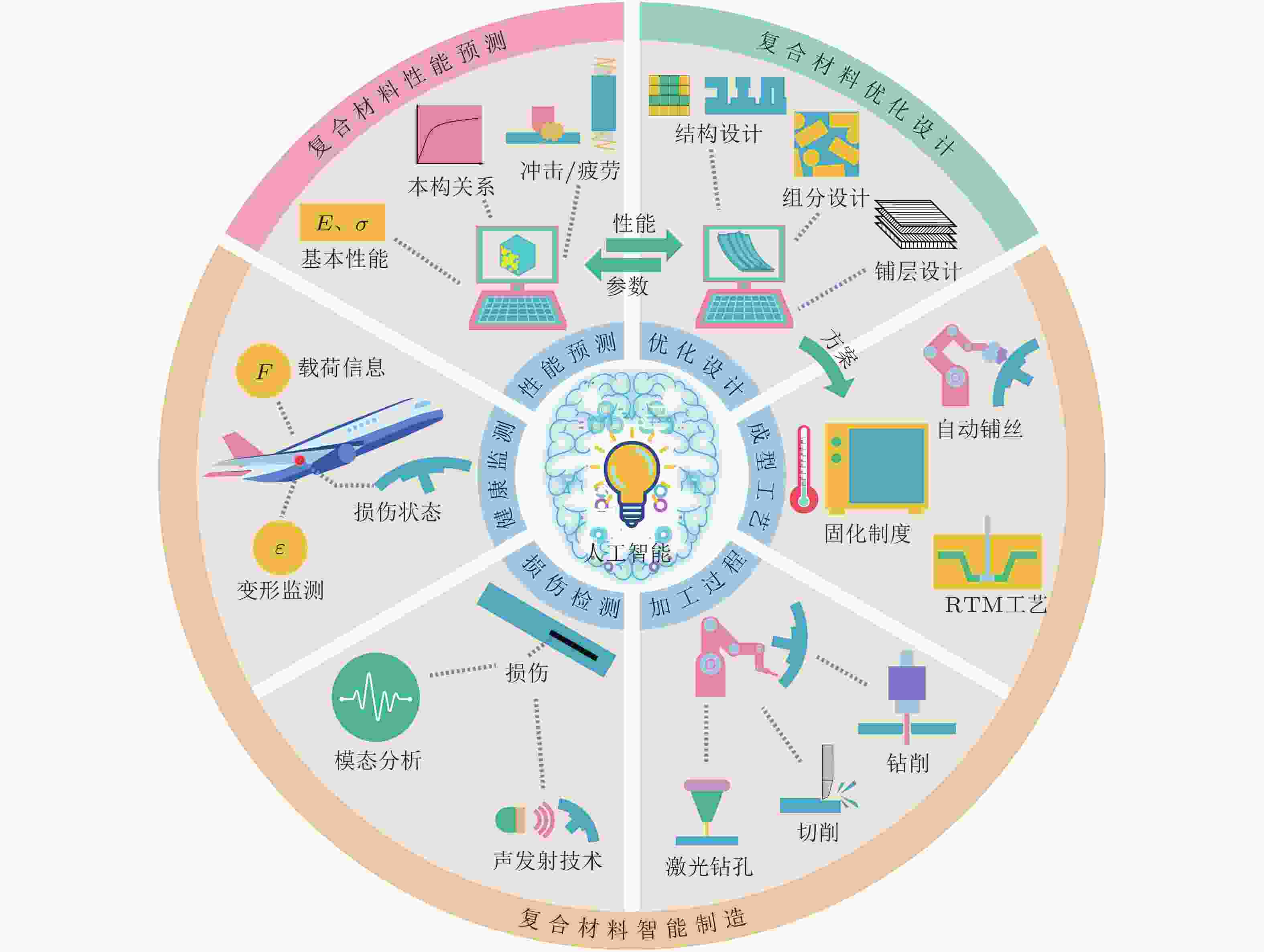
 下载:
下载:
